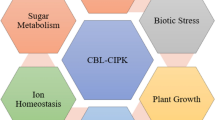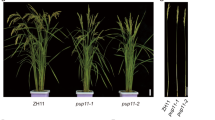Abstract
Aspartate aminotransferase (AAT) is a key enzyme in the synthesis of amino acids. It plays an important role in regulating carbon and nitrogen metabolism in almost all organisms. In this study, we over-expressed in rice separately all three AAT genes from rice (OsAAT1~3) and one AAT gene from Escherichia coli (EcAAT). Over-expression was driven by the CaMV 35S promoter and constructs were introduced into rice by Agrobacterium tumefaciens-mediated transformation. Compared with control plants, the transformants showed significantly increased leaf AAT activity and greater seed amino acid and protein contents. No other phenotypic changes were observed. The total leaf AAT activities in plants over-expressing OsAAT1, OsAAT2, and EcAAT were 26.6, 23.6, and 19.6 A min−1 mg−1 FW (A: units of activity, defined as increase of absorbency per min per mg; FW: fresh weight), which were significantly higher than that in the wild-type control (17.7 A min−1 mg−1 FW). The amino acid content in seeds of transgenic plants over-expressing OsAAT1, OsAAT2, and EcAAT was 119.36, 115.36, and 113.72 mg g−1, respectively, which were 16.1, 12.0, and 5.4% higher, respectively, than that in the control plants. The transgenic plants over-expressing OsAAT1, OsAAT2, and EcAAT had significantly higher protein contents (increased 22.2, 21.1, and 11.1%, respectively) than wild-type plants. No significant changes were found in leaf AAT activity, seed amino acid content or protein content in OsAAT3 over-expressed plants. The expression patterns of the three OsAAT genes and their different functions are also discussed.






Similar content being viewed by others
References
Bradford MM (1976) A rapid and sensitive method for the quantitation of microgram quantities of protein utilizing the principle of protein binding. Anal Biochem 72:248–254
Bryan JK (1980) Synthesis of the aspartate family and branched-chain amino acids. In: Stumpf PK, Conn EE (eds) The biochemistry of plants: a comprehensive treatise. Academic Press, New York, pp 403–452
Cai HM, Zhou Y, Xiao JH, Li XH, Zhang QF, Lian XM (2008) Overexpressed glutamine synthetase gene modifies nitrogen metabolism and abiotic stress responses in rice. Plant Cell Rep (in press)
Chavan JK, Duggal SK (1978) Studies on the essential amino acid composition, protein fractions and biological value (BV) of some varieties of rice. J Sci Food Agric 29:225–229
Chu ZH, Peng KM, Zhang LD, Zhou B, Wei J, Wang SP (2003) Construction and characterization of a normalized whole-life-cycle cDNA library of rice. Chin Sci Bull 48:229–235
Coruzzi GM (2003) Primary N-assimilation into amino acids in Arabidopsis. In: Somerville CR, Meyerowitz EM (eds) The Arabidopsis book. American Society of Plant Biologists, Rockville, pp 1–17
Coruzzi GM, Last R (2000) Amino acids. In: Buchanan BB, Gruissem W, Jones RL (eds) Biochemistry and molecular biology of plants. American Society of Plant Physiologists, Rockville, pp 358–410
Falco SC, Guida T, Locke M, Mauvais J, Sanders C, Ward RT, Webber P (1995) Transgenic canola and soybean seeds with increased lysine. Bio/Technology 13:577–582
Ferrario MS, Suzuki A, Kunz C, Valadier MH, Roux Y, Hirel B, Foyer CH (2000) Modulation of amino acid metabolism in transformed tobacco plants deficient in Fd-GOGAT. Plant Soil 221:67–79
Garg AK, Kim JK, Owens TG, Ranwala AP, Choi YD, Kochian LV, Wu RJ (2002) Trehalose accumulation in rice plants confers high tolerance levels to different abiotic stresses. Proc Natl Acad Sci USA 99:15898–15903
Gelfand DH, Rudo N (1977) Mapping of the aspartate and aromatic amino acid aminotransferase genes tyrB and aspC. J Bacteriol 133:441–444
Givan CV (1980) Aminotransferases in higher plants. In: Stumpf PK, Conn EE (eds) The biochemistry of plants. Academic Press, New York, pp 329–357
Gordon SA, Fleck A, Bell J (1978) Optimal conditions for the estimation of ammonium by the Berthelot reaction. Ann Clin Biochem 15:270–275
Hatch MD, Osmond CB (1973) Activity, location, and role of aspartate aminotransferase isoenzymes in leaves with C4 pathway photosynthesis. Arch Biochem Biophys 156:195–206
Heber U, Heldt HW (1981) The chloroplast envelope: structure, function and role in leaf metabolism. Annu Rev Plant Physiol 32:139–168
Hiei Y, Ohta S, Komari T, Kumashiro T (1994) Efficient transformation of rice (Oryza sativa L.) mediated by Agrobacterium and sequence analysis of the boundaries of the T-DNA. Plant J 6:271–282
Joachim J, Richard AP, Ursula S, Johan NJ (1994) Three-dimensional structure of a mutant E. coli aspartate aminotransferase with increased enzymic activity. Protein Eng 7:605–612
Karcicio M, Izbirak A (2003) Isozyme variations in some Aegilops L. and Triticum L. species collected from Central Anatolia. Turk J Bot 27:433–440
Lin YJ, Zhang QF (2005) Optimising the tissue culture conditions for high efficiency transformation of indica rice. Plant Cell Rep 23:540–547
Marcin M, Andrzej P (2004) Genetic control of aspartate aminotransferase isoenzymes in Aegilops and Triticum species. J Appl Genet 45:411–417
Melo PM, Lima LM, Santos IM, Carvalho HG, Cullimore JV (2003) Expression of the plastid-located glutamine synthetase of Medicago truncatula. Accumulation of the precursor in root nodules reveals an in vivo control at the level of protein import into plastids. Plant Physiol 132:390–399
Mett VL, Podivinsky E, Tennant AM, Lochhead LP, Jones WT, Reynolds PHS (1996) A system for tissue-specific copper controllable gene expression in transgenic plants: nodule-specific antisense of aspartate aminotransferase-P2. Transgenic Res 5:105–113
Miesak BH, Coruzzi GM (2002) Molecular and physiological analysis of Arabidopsis mutants defective in cytosolic or chloroplastic aspartate aminotransferase. Plant Physiol 129:650–660
Murooka Y, Mori Y, Hayashi M (2002) Variation of the amino acid content of Arabidopsis seeds by expressing soybean aspartate aminotransferase gene. J Biosci Bioeng 94:225–230
Murray MG, Thompson WF (1980) Rapid isolation of high molecular weight plan DNA. Nucleic Acids Res 8:4321–4325
Oliveira IC, Brears T, Knight TJ, Clark A, Coruzzi GM (2002) Overexpression of cytosolic glutamine synthetase: relation to nitrogen, light, and photorespiration. Plant Physiol 129:1170–1180
Rawstone S, Michin FR, Summerfield RJ, Cookson C, Coombs J (1980) Carbon and nitrogen metabolism in legume root nodules. Phytochemistry 19:341–355
Rudman D, Meister A (1953) Transamination in Escherichia coli. J Biol 200:591–604
Ryan E, Fottrell PF (1974) Subcellular localization of enzymes involved in the assimilation of ammonia by soybean root nodules. Plant Mol Biol 19:2647–2652
Sambrook J, Russell DW (2001) Molecular cloning: a laboratory manual, 3rd edn. Cold Spring Harbor Laboratory Press, Cold Spring Harbor, pp 1.31–1.119
Sentoku N, Taniguchi M, Sugiyama T, Ishimaru K, Ohsugi R, Takaiwa F, Toki S (2000) Analysis of the transgenic tobacco plants expressing Panicum miliaceum aspartate aminotransferase genes. Plant Cell Rep 19:598–603
Setoyama C, Ding S, Choudhury BK, Joh T, Takeshima H, Suzuki T, Shimada K (1990) Regulatory regions of the mitochondrial and cytosolic isoenzymes genes participating in the malate–aspartate shuttle. J Biol Chem 265:1293–1299
Shaul O, Galili G (1992) Threonine overproduction in transgenic tobacco plants expressing a mutant desensitized aspartate kinase of Escherichia coli. Plant Physiol 100:1157–1163
Song J, Yamamoto K, Shomura A, Yano M, Minobe Y, Sasaki T (1996) Characterization and mapping of cDNA encoding aspartate aminotransferase in rice, Oryza sativa L. DNA Res 3:303–310
Sotelo A, Sousa V, Montalvo I, Hernandez M, Hernandez AL (1990) Chemical composition of different fractions of 12 Mexican varieties of rice obtained during milling. Cereal Chem 67(2):209–212
Walther E, Kerstin B, Hubert K (1999) Regulation of inducible nitric oxide synthase expression in β cells by environmental factors: heavy metals. Biochem J 338:695–700
Wang WM, Zhao Q, Yu JJ, Zhu DY, Ao GM (2005) Transfer of high lysine gene sb401 into rice and analysis for protein and amino acid content in transgenic rice seeds. Acta Agronom Sinica 31:603–607
Wilkie SE, Roper JM, Smith AG, Warren MJ (1995) Isolation, characterisation and expression of a cDNA clone encoding plastid aspartate aminotransferase from Arabidopsis thaliana. Plant Mol Biol 27:1227–1233
Wu LH, Jiang SH, Tao QN (1998) The method of mensurate enzyme activity of plant GOT and GPT. Chin J Soil Sci 29(2):136–138
Wu CY, Li XJ, Yuan WY, Chen GX, Kilian A, Li J, Xu CG, Zhou DX, Wang SP, Zhang QF (2003) Development of enhancer trap lines for functional analysis of the rice genome. Plant J 35:418–427
Xiao BZ, Huang YM, Tang N, Xiong LZ (2007) Over-expression of a LEA gene in rice improves drought resistance under the field conditions. Theor Appl Genet 115:35–46
Yoshida S, Forno D, Cock J, Gomez K (1976) Laboratory manual for physiological studies of rice. International Rice Research Institute, Manila, pp 61–65
Acknowledgments
This research was supported in part by grants from the National Basic Research Program of China (2005CB120905), the National Special Key Project of China on Functional Genomics of Major Plants and Animals, the National Natural Science Foundation of China and the Cultivation Fund of the Key Scientific and Technical Innovation Project, Ministry of Education of China (No. 707045). We thank Lizhong Xiong and John Bennett for helpful comments on the manuscript.
Author information
Authors and Affiliations
Corresponding author
Additional information
Communicated by T. Tai.
Rights and permissions
About this article
Cite this article
Zhou, Y., Cai, H., Xiao, J. et al. Over-expression of aspartate aminotransferase genes in rice resulted in altered nitrogen metabolism and increased amino acid content in seeds. Theor Appl Genet 118, 1381–1390 (2009). https://doi.org/10.1007/s00122-009-0988-3
Received:
Accepted:
Published:
Issue Date:
DOI: https://doi.org/10.1007/s00122-009-0988-3




